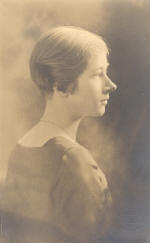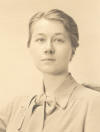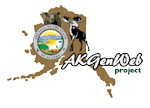HERBERT BREMNER
Pfc. Herbert Bremner, Tlingit, of Yakutat, Alaska, has been given
the Bronze Star for heroic action in Holland in WWII.
"While the
Anti-Tank Platoon which was supporting the assault battalion was
moving its weapons forward to engage four enemy tanks which were
holding up the progress of the battalion, two of the prime movers
were damaged by intense mortar and machine gun fire, and it was
necessary to repair them before they could be used to move the
weapons into position without regard, for his personal safety.
Private Bremner manned the machine gun, which was in an exposed
position on top of one of the vehicles. His determined, accurate
fire forced the enemy tanks to withdraw, thus permitting the
battalion to advance to its objective. The high standard of courage
of Private Bremner was a large factor in enabling the battalion to
gain its objective and is a distinct credit to this soldier and the
military service."
FREDERICA DE LAGUNA
1904-2004



The Life of Frederica de Laguna - Part 1
The career of Frederica de Laguna, Freddy, as she was called by
her friends, spanned more than 70 years. She began her
anthropological studies in 1927 at Columbia University, went to do
research in France, England and Denmark, then started fieldwork in
Greenland.
She was one of the anthropologists / archeologists
who worked to establish archaeological and ethnological research in
Alaska in the 1930s doing ground breaking field work among the
Alaskan people from Prince William Sound with the Chugash and the
Eyak, then the Tanaina and Ingalik and other groups of the Yukon
Valley; she began working with the Tlingit people doing
archaeological work, then included the Atna of the Copper River
Valley.
Freddy repeatedly visited the Tlingit community of
Yakutat for the monumental ethnographic work for which she is best
known. Under Mount Saint Elias: The History and Culture of the
Yakutat Tlingit, her groundbreaking holistic study of the
archaeology, ethnohistory and ethnography of one culture, was
published by the Smithsonian Institution in 1972.
She was to
be honoured later for her Yakutat work at a potlatch in 1997 which
became the focus for a documentary about her work: Reunion Under
Mount Saint Elias directed by Laura Bliss. Meanwhile, she had begun
teaching at Bryn Mawr College where she established and developed an
anthropology program until it became a full fledged department
(1967) with its own graduate program. She served on a number of
professional associations and her work was recognized by colleagues
and native communities alike.
Freddy continued her beloved
research work until the last days of her life. She completed the
manuscript for a new edition of the three volumes of Under Mount St
Elias. At the time of her death, she was also working on the
biography of a Tlingit woman whom she had known in Yakutat, and on a
new series of books for students (Northern Encounters), including a
presentation of the Eyak people of Alaska, and another on the
Greenlandic people. She was still in touch with colleagues, students
and friends and was also busy managing her small independent
academic press, the Frederica de Laguna Northern Books, started in
2001, with three titles already in press.
Until the end, her
activities spanned the Northern regions to which she had devoted her
life, and the various fields of enquiries which composed her well
known holistic perspective on anthropology as the specific
discipline located at the crossroad of many social and human
sciences. She continued to be involved in the fulfilment of what she
regarded as a main duty of the anthropologist, communication with
both the communities under study and the public at large.
Freddy's story begins with her father, Theodore Lopez de Leo de
Laguna and mother, Grace Mead Andrus, who had both received
Doctorates from Cornell. In 1907, they came to Bryn Mawr College,
where both were to teach philosophy. Freddy, born in Ann Arbor
(Michigan) 1906, was then one year old. Freddy was home-schooled
until she was 9. In 1914-15, she went with her parents and her baby
brother to France where she witnessed the start of the First World
War. She would go back in 1921-22 and spend 6 months in a French
“lycée de jeunes filles” at Versailles. Her parents actively
supported her work, and her mother, a renowned scholar herself, was
to accompany Freddy during several of her field work experiences.
After graduation,Summa Cum Laude, in 1927 from Bryn Mawr
College, Freddy studied at Columbia under Franz Boas, and took
classes with Ruth Benedict and Gladys Reichard at Barnard (1927-31).
In 1928, she also studied prehistory in a summer field school in
France under George Grant McCurdy of Yale. She visited prehistoric
sites such as the cave paintings at Altamira in Spain. She met the
Abbé Breuil in the cavern of the Trois Frères where he was sketching
the remarkable frieze of horses below the “sorcerer” on the rock
walls of the cavern. She wrote that bare foot prints and hand marks
of prehistoric adults and children were still fresh in the mud. That
fall in Paris, she studied Palaeolithic art with the Abbé Breuil and
took lessons with Marcellin Boule at the Institut de Paléontologie
Humaine and Paul Rivet, curator of the Musée d’Ethnologie, in the
old Trocadero building.
Then she went to London to read at
the British Museum, and in 1929, she matriculated at the London
School of Economics where she signed up for, among other courses, a
seminar on “Magic, Science, and Religion” given by Bronislaw
Malinowski. She then went on to study Palaeolithic and Eskimo
collections in European and Scandinavian museums. In Denmark, she
met Kaj Birket Smith and Therkel Mathiassen. The later asked her to
be his research assistant on digs of Eskimo archaeological sites in
Arctic Greenland (the Inuksuk site contained Norse artifacts as
well). Instead of staying for the projected six weeks, she served a
six month apprenticeship (1929). While there, she met Knud Rasmussen
and other polar explorers. This first fieldwork experience marked a
decisive moment in her career: she decided to devote her life to
anthropological research and she maintained an interest in the
Arctic and especially in Greenland to the end of her career. In
1979, she returned there for fieldwork after having taken lessons in
Danish and renewing her friendship with colleagues in Denmark.
In 1930, before even completing her PhD, she had began her
career in Alaskan archaeology with a survey of potential
archaeological sites in Prince William Sound and Cook Inlet. Kaj
Birket-Smith who was supposed to head the expedition fell sick and
Freddy persuaded the Museum to let her go by herself. She received
her PhD in Anthropology (Columbia 1933) in absentia while doing
fieldwork in Alaska for the University of Pennsylvania Museum, WPA.
Her excavations in 1931-32 established the basic sequence of
prehistoric Pacific Eskimo (Alutiiq) cultures, including that now
known as the “Kachemak Tradition”. During this period, she
encountered, then identified, the Eyak Indians as a separate
linguistic community.
In 1933, Freddy was joint leader with
Kaj Birket-Smith of an archaeological-ethnological investigation of
the Eyak Indians; the outcome was a joint publication, The Eyak
Indians of the Copper River Delta, Alaska (Birket-Smith and de
Laguna 1938) and a double publication on the Chugach Eskimo of
Prince William Sound: he wrote their ethnography (1953) and she
dealt with their prehistory and mythology (1956). In 1934, the
University Museum published the results of her Alaskan excavations,
The Archaeology of Cook Inlet, Alaska, with a grant from the
American Council of Learned Societies (second revised edition, 1975,
Alaska Historical Society).
A couple of years later, in 1935,
Freddy led an archaeological and geological expedition on the middle
and lower Yukon drainage. She traveled more than 2000 km through the
interior of Alaska, in the hopes of discovering traces of the First
American, or Paleo-Indians. Though this wish was thwarted, the group
collected data on potential archaeological sites in the Yukon Valley
and Freddy accumulated ethnographic data on the Athapaskan Indian
people. The report on these archaeological activities in the Yukon
Valley, The Prehistory of Northern North America as Seen from the
Yukon (1947), had to wait until after the war to be published. The
ethnographic data was not to be read by others until much later with
the publication of Tales from the Dena (1995) and Travels Among the
Dena: Exploring Alaska’s Yukon Valley (2000). Her survey of
“Matrilineal Kin Groups in Northwestern North America,” Proceedings:
Northern Athapaskan Conference, 1971, vol. 1, 17-145 (1975) also
derives from the information she began collecting at that time.
The Depression cut short her trips to Alaska but allowed her to
go to the only other area in North America where real archaeological
sequences had been established: the Southwest. Thus she was able to
make personal contact with members of many different western
American aboriginal communities from British Columbia to California
as in 1936, she and her mother embarked on a trip to visit sites,
museums and colleagues, as well as North American Indian
communities. Her introduction to these people was often with the
guidance of the leading scholars who knew them best: Alfred Kroeber
and Ruth Benedict with her writings on patternings in psychological
terms, as the ethos or personality of a culture became major
influences in her thinking. She also befriended Ruth Underhill,
Harold Colton, Gladys Reichard, Erna Gunther, Viola Garfield, Marian
Smith, William Fenton, Harlan I. Smith, T.F. McIlwraith and Henry
Collins, Irving Hallowell and his wife among others.
In 1939,
Freddy was elected president of the Philadelphia Anthropological
Society (1939-40) and in 1941, she became Assistant Professor at
Bryn Mawr College. The U.S. entry into the Second World War,
however, led to a detour in her career. In September 1942, Frederica
de Laguna joined the Naval Reserve as a lieutenant (junior grade),
becoming one of the first teachers at the Naval Reserve Midshipmen's
School for Women on the Smith College Campus at Northhampton. Her
specialty was communications (codes and ciphers). The following year
(1943), she was transferred to Naval Intelligence in Washington D.C.
where she eventually reached the rank of Lieutenant Commander just
after Japan's surrender.
After the end of the war, Freddy
retired from the Navy, but left with a deep respect for the Navy, an
enduring interest in ships and naval history from the time of
Captain Cook to the present, and a strong contempt for institutions
that were uanble to recognize the potential of women.
Freddy
returned to her own field, planning an ambitious project that
combined archaeological, historical and ethnographic disciplines
into a comprehensive study of Tlingit culture. She hoped to trace
the development of a recognizable Tlingit pattern from the culture's
early appearance to modern times. In 1949, she began surveying
Northern Tlingit communities on the Gulf Coast of Alaska including
Yakutat. That same year, she was elected vice-president of the
Society for American Archaeology (1949-50). In 1950, Freddy brought
a team of researchers to Angoon, Admiralty Island in Southern Alaska
where she joined efforts with Viola Garfield. This collaboration led
to the writing of The Story of a Tlingit Village: A Problem in the
Relationship Between Archeological, Ethnological, and Historical
Methods (1960) which laid the methodological foundations for her
later research.
With the collaboration of Catharine (“Kitty”)
McClellan, one of her graduate students who had become her close
collaborator, she moved from Angoon back to Yakutat. There, the
research later published as Under Mount Saint Elias: The history and
culture of the Yakutat Tlingit (Smithsonian contributions to
anthropology) (1972), took shape as Freddy came back every time she
could, becoming more and more attached to the community. The
resulting 3 volumes were hailed both by both the scientific
community and the Yakutat people themselves. In fact, the Yakutat
people rewarded her with a special celebration during a potlatch in
1997. Her return ahd the celebration became the topic of an
award-winning documentary by Laura Bliss, Reunion Under Mount Saint
Elias: The Return of Frederica de Laguna.
It was during this
time (1965-1967)that Freddy and Kitty began to work on the Atna,
Athabaskans of the Copper River, and their neighbours on the upper
Tanana. At the same time, Kitty conducted additional research of her
own in the Yukon territory. Together, they perfected research
methods in ethnography with Freddy moving toward a perception of
research as a dialogical enterprise.
In 1965, Freddy became
president of the American Anthropological Association (1965-1966),
She was re-elected in 1966 (1966-1967). In 1975, Frederica de Laguna
and Margaret Mead became the first female anthropologists elected to
membership in the National Academy of Science.
|





